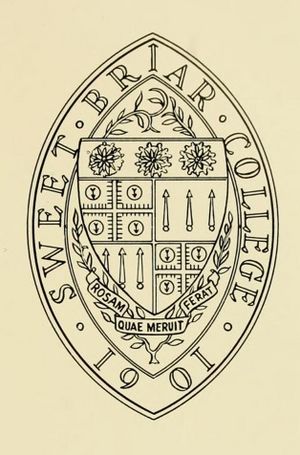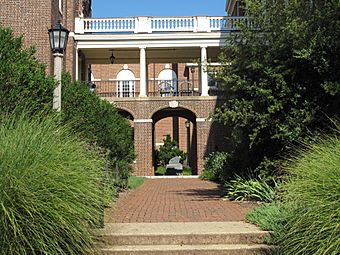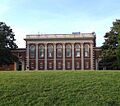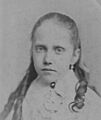Sweet Briar College facts for kids
 |
|
| Motto | Rosam quae meruit ferat (Latin) |
|---|---|
|
Motto in English
|
She who has earned the rose may bear it |
| Type | Private women's liberal arts college |
| Established | 1901 |
| Endowment | $73.9 million (2017) |
| President | Mary Pope M. Hutson |
|
Academic staff
|
55 (fall 2020) |
| Students | 353 (fall 2020) |
| Location |
Amherst County, Virginia, U.S.
,
U.S.
|
| Campus | Rural, historic, 2,840 acres (1,150 ha) |
| Colors | Pink and green |
| Nickname | Vixens |
|
Sporting affiliations
|
NCAA Division III, ODAC |
Sweet Briar College is a private college for women in Sweet Briar, Amherst County, Virginia. It is a liberal arts college, which means it offers a wide range of subjects. The college was started in 1901 by Indiana Fletcher Williams. She created it to honor her daughter, Daisy, who had passed away.
The college officially opened in 1906. It started giving out Bachelor of Arts (B.A.) degrees in 1910. In 2015, the college almost closed down. However, it was saved by many generous donations and legal help from its former students.
Sweet Briar is famous for its beautiful campus. It has historic buildings designed in the Georgian Revival style. The campus also includes about 3,250 acres of hills, forests, and fields.
Contents
The Story of Sweet Briar College
How the College Got Its Name
The college is named after a large property called Sweet Briar plantation. This land belonged to Elijah Fletcher and his family. Elijah Fletcher was a teacher and businessman in the 1800s. He also served as the mayor of Lynchburg, Virginia.
Fletcher owned many enslaved people who worked on his land. He bought the Sweet Briar property in 1813. His wife, Maria Antoinette Crawford, is said to have named it "Sweet Briar." She chose the name because of the many roses growing there.
A Daughter's Legacy
Indiana Fletcher, Elijah's daughter, was born in 1828. She later married James Henry Williams. Their daughter, Maria Georgiana, was born in 1867. Everyone called her "Daisy."
When Elijah Fletcher passed away, Indiana inherited the Sweet Briar property. Sadly, Daisy Williams died at the young age of 16 in 1884. Her parents were heartbroken. James Williams wished that a school could be built to honor Daisy.
After James and Indiana passed away, Indiana's will stated her wish. She wanted the Sweet Briar property to become a school for young women. This dream came true in 1901.
Opening the College Doors
In 1901, Sweet Briar Institute received its official charter. This was thanks to Indiana Fletcher Williams's will. Her will said the school should educate "white girls and young women." It aimed to teach them "sound learning" and "physical, moral and religious training." The goal was to help them become "useful members of society."
Sweet Briar College welcomed its first 51 students in 1906. By 1910, it was already granting degrees. The college also started international programs early on. In 1932, it began an exchange program with the University of St. Andrews in Scotland. In 1948, the famous Junior Year in France (JYF) program started. Many other study abroad programs followed.
Changes During the Civil Rights Era
The college's original charter only allowed white students. To admit African-American students, legal changes were needed. This was important to follow the Civil Rights Act of 1964.
In 1964, Sweet Briar asked the court to remove the word "white" from its charter. At first, this request was denied. After several years, the college took its case to a federal court. In 1966, a judge issued an order. This order stopped the college from enforcing the racial restriction.
The first African-American student, Marshalyn Yeargin-Allsopp, joined Sweet Briar in September 1966.
Sweet Briar's Unique Approach to Learning
Sweet Briar College has always had a strong reputation for academics. Early on, the college wanted to offer a unique education. It included "hands-on" or "practical" courses. It also focused on physical education. This was to help students become "useful members of society."
This idea helped shape the college's main goal. Students could get direct experience in their subjects. They learned both in the classroom and in real-world settings. Over time, this approach developed into a more traditional liberal arts curriculum.
The College Almost Closes in 2015
The Announcement to Close
On March 3, 2015, the college's leaders made a sad announcement. They said Sweet Briar College would close on August 25, 2015. They explained it was due to "insurmountable financial challenges." This meant they felt they did not have enough money to keep going.
They mentioned fewer students were enrolling. Also, the college's money fund (endowment) was not enough. It could not cover big changes needed to get more students. The leaders also thought fewer students were interested in women's colleges.
The college had tried to join with other schools, but it didn't work out. Many professors received notices that their jobs would end.
Efforts to Save the College
A group of former students, current students, and supporters worked together. They called themselves "Saving Sweet Briar." They wanted to stop the college from closing. They used legal action, social media, and a fundraising campaign.
They argued that the financial problems were not as bad as stated. They also asked the college president and board to step down. The president and board refused.
Many faculty members also opposed the closing. They filed a lawsuit to stop the closure. The Amherst County Attorney also filed a lawsuit on behalf of Virginia. This lawsuit aimed to block the closing and change the college's leadership.
A judge issued an order to prevent the college from moving its endowment money. This money was meant for the college's continued operation. The college was still allowed to continue its closing process using other funds.
More lawsuits followed. Students, parents, and former students filed a lawsuit. They said the decision to close broke a contract. A judge then ruled that the college could not sell any of its assets for six months. However, the judge still did not stop the closing itself.
Agreement to Keep the College Open
On June 20, 2015, good news arrived. The Virginia Attorney General's office announced an agreement. Sweet Briar College would stay open for the 2015–16 school year!
The agreement stated that the college president, James Jones, would resign. Also, at least 13 members of the college's board would leave. This allowed "Saving Sweet Briar" to appoint a new majority of board members.
"Saving Sweet Briar" agreed to raise $12 million. The state Attorney General agreed to release $16 million from the college's endowment. This money would help pay for the college to keep running. On June 22, 2015, a judge approved the agreement. All the lawsuits were then dropped.
A New Beginning for Sweet Briar
New Leadership and Financial Stability
In July 2015, a new board of directors was chosen. They quickly appointed Phillip Stone as the new president. The new board officially canceled the previous decision to close the school.
President Stone said he planned to help the college grow. He wanted to enroll even more students than before. Most faculty and staff were invited to stay. "Saving Sweet Briar" successfully raised over $12 million by September 2015. This helped cover the college's operating costs. The college's finances became strong enough that they did not need to use the $16 million from the endowment.
In 2017, Meredith Jung-En Woo became the 13th president of the college.
Changes to Learning Programs
Under President Woo, the college made big changes to its academic programs. Starting in fall 2018, it removed traditional departments. Instead, it created three "centers":
- Engineering, Science and Technology in Society
- Human and Environmental Sustainability
- Creativity, Design and the Arts
The old general education requirements were replaced. A new core curriculum focused on women's leadership was introduced. The school also changed its semester system. It moved to "3-12-12-3"-week semesters. The shorter three-week terms allow for special activities. These include intensive classes, study abroad, and research projects.
Financial Health and Student Numbers
In January 2016, the college announced good news about student applications. It received over 1,000 applications for the 2016–2017 school year.
In 2018, a group that checks colleges (the Southern Association of Colleges and Schools Commission on Colleges) put Sweet Briar on "warning" status. This was based on its finances. The college had to show its finances were strong and well-managed within a year. If not, it could lose its accreditation. Losing accreditation means students cannot get federal financial aid. In June 2019, the "warning" status was removed. This showed the college had improved its financial situation.
College Presidents
- Mary K. Benedict (1906–1916)
- Emilie Watts McVea (1916–1925)
- Meta Glass (1925–1946)
- Martha B. Lucas (1946–1950)
- Anne Gary Pannell (1950–1971)
- Harold B. Whiteman Jr. (1971–1983)
- Nenah Elinor Fry (1983–1990)
- Barbara A. Hill (1990–1996)
- Elisabeth Showalter Muhlenfeld (1996–2009)
- Jo Ellen Parker (2009–2014)
- James F. Jones Jr. (interim president, 2014–2015)
- Phillip C. Stone (2015–2017)
- Meredith Jung-En Woo (2017–2023)
- Mary Pope Maybank Hutson (2023–present)
What Students Learn at Sweet Briar
Sweet Briar College offers many different study areas. Students can choose from 17 majors and 21 minors. They also have programs to prepare for law school, medical school, or veterinary school. The college offers two certificate programs: arts management and equine studies. Students can also get a teaching license in 10 subjects. There is also one graduate degree: a Master of Arts in Teaching.
The college offers Bachelor of Arts, Bachelor of Fine Arts, and Bachelor of Science degrees. Sweet Briar is special because it is one of only two women's colleges to offer an engineering degree. This degree is approved by ABET, a group that checks engineering programs.
Sweet Briar has a small student-to-faculty ratio, about 9 students for every 1 teacher. Most classes have fewer than 20 students. This means students get a lot of personal attention.
The college also has many study abroad programs. Many focus on learning foreign languages. The Junior Year in France (JYF) program is very popular. Other programs include studying in Japan, China, Rome, and Athens. Students can also earn credit for international internships.
Sweet Briar offers special awards and money for students. These help them with their studies:
- Sweet Briar College's Honors Program gives money to students. This supports their independent research projects. Teachers help guide these projects.
- Student Research and Creative Endeavors Grants give up to $500. This helps cover costs for student research or creative projects.
- Student Travel Grants from the Honors Program help pay for academic travel. This includes trips during the school year.
- Several scholarships are available for academic travel. These can be used to attend conferences.
Sweet Briar's Buildings and History
|
Sweet Briar College Historic District
|
|

Arcade between Pannell Art Gallery and Randolph Hall
|
|
| Location | Sweet Briar Dr., 0.5 miles west of US 29, Amherst, Virginia |
|---|---|
| Area | 27.2 acres (11.0 ha) |
| Architect | Ralph Adams Cram; et al. |
| Architectural style | Colonial Revival |
| NRHP reference No. | 95000240 |
| Significant dates | |
| Added to NRHP | March 30, 1995 |
The buildings at Sweet Briar College were mostly designed by Ralph Adams Cram. He also designed buildings for Princeton University and West Point. Even though Cram was known for Gothic Revival style, he designed Sweet Briar in the Colonial Revival style. This means the buildings are made of red brick with white railings and archways.
Twenty-one of the college's buildings are part of the "Sweet Briar College Historic District." This district is listed on the National Register of Historic Places. Sweet Briar House, where the college president lives, is one of these buildings.
The campus also has a burial ground from the old plantation. It is known as the slave cemetery. Over 60 enslaved people are buried there. Archaeologists have found many items from enslaved people on campus. There is also a slave cabin from the 1840s behind Sweet Briar House. This cabin was also used by early college employees.
Many college teachers and staff live on campus. They rent or own homes on land that belongs to the college.
Life at Sweet Briar College
Sweet Briar is a residential campus. This means almost all students live on campus. There are seven dormitories and other living options for older students. The college has over 50 clubs and groups for students to join.
Like other women's colleges, Sweet Briar has many traditions. The most important one is Founder's Day. On this day, students, teachers, and staff walk to Monument Hill. They place daisies at Daisy Williams's grave and memorial.
Sweet Briar Athletics
Sweet Briar's sports teams are called the Vixens. The college is part of the NCAA Division III. It mostly competes in the Old Dominion Athletic Conference (ODAC).
Sweet Briar has nine varsity sports teams for women:
- Cross country
- Equestrian (horseback riding)
- Field hockey
- Golf
- Lacrosse
- Soccer
- Softball
- Swimming
- Tennis
Fencing is also a club sport at Sweet Briar.
Students can also join recreational sports through the Sweet Briar Outdoor Program (SWEBOP). This program organizes trips throughout the year. These trips include hiking, fly fishing, caving, rock climbing, kayaking, and skiing.
Horseback Riding Program
The college is very well known for its horseback riding program. It focuses on show and field hunters, hunt seat equitation, and show jumping. The school has seven riding teams. These include a jumper team, a hunter show team, and an Intercollegiate Horse Show Association (IHSA) team. Students can also earn an Equine Studies Certificate. This certificate focuses on horse training or equine management.
Sweet Briar has won many awards in riding. They have won four ODAC titles. They also have nine ANRC team national championship titles. Sweet Briar students have been individual national champions nine times. In 2006 and 2008, the IHSA team did very well at Nationals.
Well-Known People from Sweet Briar
Former Students (Alumnae)
- Irene Beasley, an entertainer
- Colleen Bell, a former U.S. Ambassador to Hungary
- Janet Lee Bouvier, mother of Jacqueline Kennedy Onassis
- Leah Busque, founder of TaskRabbit, a company that helps people find help for tasks
- Verda Colvin, a Justice on the Supreme Court of Georgia
- Katherine Emery, an actress
- Lendon Gray, an Olympic dressage rider
- Molly Haskell, a feminist film critic and author
- Diana Muldaur, an actor and former president of the Academy of Television Arts & Sciences
- Mary Lee Settle, an author who won the National Book Award
- Ann Taylor, a newscaster
- Marshalyn Yeargin-Allsopp, the first African-American student at Sweet Briar College. She is a director at the Centers for Disease Control and Prevention.
Teachers (Faculty)
- Carrie Brown – A novelist and English professor
- John Gregory Brown – An English professor and novelist
Past Teachers
- Lincoln Pierson Brower – A world expert on monarch butterflies
- Cornelius Eady – A poet
- Mary Oliver – A poet who won the Pulitzer Prize
- Barbara A. Perry – A government professor and author
Images for kids








